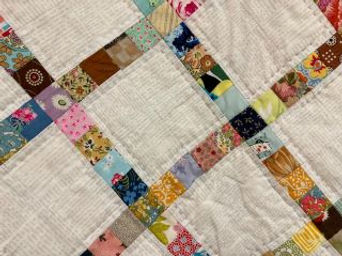Orpington Quilters

Orpington Quilters

At our July 2022 meeting the guest speaker was was Carolyn Forster, a great advocate of hand quilting quickly. She is the author of many books, covering such topics as quilt-on-the-go, handmade quilts and Big Stitch quilting, and her talk this month was about utility Quilting.
Utility Quilting originated from the very early days of patchwork quilting, where farmer's wives would make practical household items out of grain and seed sacks. Quilts made in this way were finished off quickly with big stitches using thick threads. This method has a place in modern quilting where the quilter wants the satisfaction of hand quilting but needs a quick way of producing the finished article.
Carolyn's interest in this technique started when she was still at school. She really enjoyed the stitching of patchwork pieces together and whilst the tops were quick to make, she wanted a speedier way to quilt her backing, wadding and top together, The Utility Quilting method uses simple, often all-over designs that are faster to complete than more complex styles.
Utility Quilting, or Big Stitch quilting, is known the world over. In Japan, children are taught big stitches in school, where old tea towels etc. are folded and stitched to make dusters to clean the classroom. And of course Sashiko (little stabs) is well known as the decorative and/or functional reinforcement of cloth and clothing.


These pictures are the front and back of a camphor quilt from India, made from bits and pieces of material and hand quilted.
This next quilt is from the USA, probably around the 1930's. It is made from a book of fabric samples and tied quilted using dish-cloth cotton or sacking ties.


Carolyn made this quilt in the early 1980's. She used 6oz polyester wadding which made it impossible to do fine hand quilting so she used big stitch quilting with embroidery floss and silk thread.
Tying is another effective way of joining the layers of the quilt together. In addition to the aesthetically pleasing finish to a quilt, it can have the added benefit of allowing quilting without basting.

These pictures show the front and detail of a stretched hexagon quilt that has been tied in tapestry wool and bagged out to negate binding it.

There a number of different types of stitching frequently used in Big Stitch quilting.

This sampler quilt is made up of strips and the Mennonite Tack stitch has been used to keep the layers together. This method involves stitching individual stitches on the surface and letting the thread travel inside the wadding to the next stitch.
The Mennonite Tack is just one of many stiches used in Utility Quilting, some of which have multiple names for the same thing depending on which church group was doing the quilting. Two examples are the Baptist Knot and the Methodist Knot. Interestingly, these groups started from the outside and worked inwards, or in lines. Both these practices are contrary to how quilts are usually put together, i.e. from the middle outwards.
This quilt has a running cross-stitch, very similar to the Mennonite Tack but with a cross-stitch on the surface.

In Utility Quilting, the pattern of the quilting can either follow the straight lines of the patchwork top, thereby accentuating it, or ignore ignore the patchwork design by using waves and circles to make a feature of the quilting.


This quilt of 1" squares is an example of Big Stitch quilting on the straight lines of the patchwork, with no need to mark it.


Here is an example of how the overlapping circles on this quilt top adds another dimension to the design.
The following pictures show the front and detail of a French Provencal quilt. It has been cross-hatched in the middle and cable in the borders.



Having given many tutorials about cabling, Carolyn created this example quilt showing different variations of the cable pattern.

This picture shows an excellent example of angular quilting, using the elbow quilting method, i.e. the distance between your elbow and hand determines the size of the quilt pattern.


And finally, here is an Amish quilt showing different techniques, including Amish Waves in the borders and a variety of intricate Big Stitch patterns on the blocks.
Carolyn's talk on Utility Quilting was really interesting and very entertaining, provoking many questions from the audience. After the talk, members poured over the example quilts she brought with her, both antique and modern, Her website is well worth a visit at www.carolynforster.co.uk.